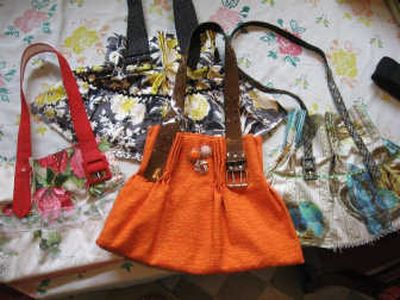Earth-friendly fashions

“Green” is the new black.
That seems to be the sentiment among fashion designers, who lately have been injecting their products with earth-friendly messages and materials. It’s hard to open a magazine or turn on the television these days without seeing celebrities touting eco-conscious statements on their T-shirts, and several conventional clothing and accessories lines now offer green collections.
Ananas is one such company. The New York City-based handbag maker recently launched a line of eco products, offering some of their most popular bag styles – many of which have been featured on the pages of “Lucky,” “Marie Claire” and other fashion magazines – made from natural fibers.
The Ruby Slipper, a shoe and accessories shop in Spokane’s Garland District, carries the bags, and owner Sue Bradley says supporting green products is something she believes in.
“We have limited natural resources, and we have to figure out a way to get things into people’s hands with the least possible damage to those resources,” she says.
The Ruby Slipper also sells floor mats make from flip flops, boots tinted with vegetable dies and a line of shoes that has reduced its packaging, among other earth-friendly products.
Like Ananas, designers such as Stella McCartney and Hennes & Mauritz (commonly known as H & M) recently have bolstered or launched their natural or organic lines. Even Converse now makes a hemp sneaker and The Gap is selling organic shirts.
The look of those clothes usually blends with the rest of the designers’ offerings. In other words, don’t expect shapeless burlap dresses and Birkenstock-style sandals. Today’s earth-friendly fashion is often chic and modern.
Sometimes, though, the eco statement is far from subtle.
Urban Outfitters sells a T-shirt that reads “save our oceans” with a cheeky image of Hello Kitty riding a dolphin. A company called Ban T-shirts sells nonsweatshop shirts made from organic cotton with messages such as “There is no planet B” and “S.O.S.,” where the “O” is replaced with an image of the earth.
Last summer, trend followers went bonkers for a tote bag created by London designer Anya Hindmarch. The bag – meant to be used for carting groceries around – had a simple message written boldly on its side: “I’m not a plastic bag.” Real plastic bags, the ubiquitous, flimsy things used at supermarkets, aren’t biodegradable and rarely are reused by consumers.
Hindmarch’s bags retailed for $15, but because there was a scarcity of them last summer, customers in New York waited in line for hours to buy them or paid hundreds of dollars for them on eBay. The auction price has dropped considerably since then, but public awareness about the plastic bag problem is higher now.
Environmental advocates often say that the greenest products of all are the ones that already exist, and Carrie Berndt understands that as well as anyone.
The Filer, Idaho, resident runs a clothing and home décor company called The Cat’s Pajamas. She sews skirts, dresses, shirts and even shower curtains out of old bedspreads, jeans, cowboy shirts and other thrift store finds.
Berndt repurposes materials for a variety of reasons.
“A lot of it comes from my mom,” she says. “She was from the nonthrow-away generation. You use anything, and make it look good.”
Berndt, who is Christian, also recycles for religious reasons.
” ‘Save the planet, go green’ is the big thing, but I’ve always done that,” she says. “We’ve been given this Earth to take care of it, and I want to do my part. … I think we need to be responsible for what God has given us.”
Berndt sells her products through her Web site, and at the semi-annual Farm Chicks Antique Show.
For Jennifer Baum Lagdameo, the designer behind the Ananas handbags, creating a line of green products took her back to her company’s roots.
She started making bags while living in the Philippines, using natural materials such as mother of pearl, coconut wood and abaca fiber, which comes from a plant similar to banana trees.
The name of her company means “pineapple” in several languages and is a nod to one of her original products: shawls made from pineapple fiber.
When Lagdameo moved her business to the United States, she began using leather. But the company never strayed far from the earthy theme – she still used natural materials like wood for handles and even the bags’ lining image is taken from a photograph of a tree that Lagdameo shot in Paris.
Still, the eco collection takes her commitment to green a step further. The bags are made from natural fibers such as abacas and canvas and are treated with a food-grade paraffin wax.
“The wax canvas gets a vintage look as you use it,” Lagdameo said during a recent telephone interview. “It’s waterproof and wears well.”
And, for every bag sold, Ananas is planting a tree in the Philippines.
Lagdameo resisted calling green fashion a trend but then acquiesced.
“Who cares if it’s a trend or not? It’s something positive,” she said. “If trends influence people for a positive thing, then that’s something that’s good.”